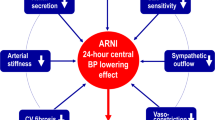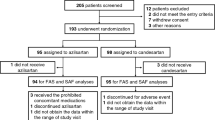Abstract
Objective: Angiotensin-converting enzyme (ACE) inhibitors have beneficial effects on arterial compliance and distensibility and favourably modify the arterial pressure waveform in hypertensive patients. The objective of our study was to explore the possible effects of adding an ATII AT1 receptor antagonist to an ACE inhibitor on augmentation pressure, a measure of arterial stiffness, and pulse pressure amplification in patients with poorly controlled essential hypertension.
Design and methods: We studied a group of 18 patients with poorly controlled hypertension, despite at least three antihypertensive drugs including an ACE inhibitor, before, at 2 h and 2 weeks following the administration of 80 mg of valsartan, an ATII AT1 receptor antagonist. Haemodynamic responses were measured by cuff sphygmomanometry, arterial pulse-wave analysis and the pulse pressure gradient was calculated as the difference between the brachial pulse pressure (cuff sphygmomanometry) and derived aortic pulse pressure (arterial pulse wave analysis).
Results: Blood pressure decreased significantly (P < 0.001) and the effect was more pronounced on central (aortic) pulse pressure than peripheral (brachial) pulse pressure. the pulse pressure amplification increased significantly (from 8 ± 3 at baseline vs 12 ± 7 at 2 h to 14 ± 5 mm Hg at 2 weeks, P < 0.01) and the augmentation pressure decreased from a baseline value of 21 ± 8 to 11 ± 7 at 2 h and 10 ± 5 at 2 weeks, (P < 0.01) following valsartan.
Conclusion: The results of our study show that in a group of poorly controlled hypertensives, combining an ATII AT1 receptor blocker to an ACE inhibitor induced a significant fall in blood pressure. The decrease in blood pressure was accompanied by a decrease in augmentation pressure in the ascending aorta with a greater decrease in the central pulse pressure than in the peripheral, favourably increasing pulse pressure amplification between central and peripheral arteries. This effect on arterial stiffness and amplification suggests that combined angiotensin II blockade by adding an AT1 receptor blocker to an ACE inhibitor may have more beneficial effects on the blood pressure curve than simple blood pressure reduction.
This is a preview of subscription content, access via your institution
Access options
Subscribe to this journal
Receive 12 digital issues and online access to articles
$119.00 per year
only $9.92 per issue
Buy this article
- Purchase on Springer Link
- Instant access to full article PDF
Prices may be subject to local taxes which are calculated during checkout
Similar content being viewed by others
Author information
Authors and Affiliations
Corresponding author
Rights and permissions
About this article
Cite this article
Mahmud, A., Feely, J. Favourable effects on arterial wave reflection and pulse pressure amplification of adding angiotensin II receptor blockade in resistant hypertension. J Hum Hypertens 14, 541–546 (2000). https://doi.org/10.1038/sj.jhh.1001053
Received:
Revised:
Accepted:
Published:
Issue Date:
DOI: https://doi.org/10.1038/sj.jhh.1001053
Keywords
This article is cited by
-
Antihypertensive drugs and central blood pressure
Current Hypertension Reports (2009)
-
Assessment of effect of angiotensin II receptor antagonist losartan on aortic distensibility in patients with essential hypertension by echocardiography
Current Medical Science (2002)
-
The effect of antihypertensive drugs on vascular compliance
Current Hypertension Reports (2001)



